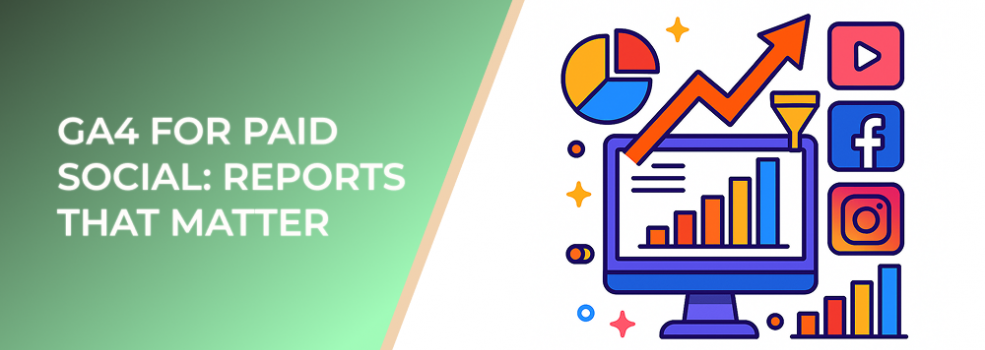Paid social campaigns generate fast-paced traffic, shifting user behaviors, and increasingly complex attribution paths. Google Analytics 4 (GA4) offers marketers the tools to measure these journeys more accurately—but only if the right reports are used. Unlike its predecessor, GA4 prioritizes event-based tracking, cross‑device measurement, and predictive modeling, making it a powerful analytics foundation for improving paid social performance.
Below are the essential GA4 reports and metrics that matter most when running and evaluating paid social campaigns.
Why GA4 Is Critical for Paid Social Measurement
Paid social drives high-intent discovery and mid‑funnel engagement, but its influence can be hard to track through traditional last‑click attribution. GA4 solves this by consolidating web and app activity and using machine learning to fill data gaps.

Average paid-social campaign ROI: $2.50 earned per $1 spent
Key advantages:
-
Event-based tracking captures nuanced engagement behaviors.
-
Cross‑device identity modeling improves attribution accuracy.
-
Built-in predictive analytics enhances retention and conversion forecasting.
-
Flexible reporting helps differentiate paid social traffic from other acquisition channels.
According to Google’s published benchmarks, companies that adopt event-based measurement experience, on average, a 15–25% improvement in attribution accuracy, resulting in better campaign optimization.
The Paid Social Reports That Matter Most in GA4
1. Traffic Acquisition Report
This report helps identify how paid social traffic behaves in comparison with other channels.

Global paid-social ad spend projected at $276.7 billion in 2025; 83% will be mobile by 2030
Key metrics to focus on:
-
Sessions from paid social sources
-
Engagement rate (GA4’s replacement for bounce rate)
-
Conversions attributed to paid social
-
Average engagement time per session
Insight example: Brands that monitor engagement metrics regularly see up to 30% higher improvement in ROAS, according to industry performance studies.
2. User Acquisition Report
This report shows the quality of new users driven by paid social.
Look especially at:
-
Engaged sessions per new user
-
Conversion value per user
-
First‑time user cohorts attributed to paid social
Paid social is often a strong driver of new user volume. Across retail and SaaS brands, new users coming from paid social campaigns tend to show 18–22% higher first‑session engagement compared to organic social.
3. Event Reporting for Paid Social Journeys
GA4’s event framework lets you measure everything from outbound link clicks to scroll depth. For paid social, this is crucial for understanding post‑click user intent.
Important events include:
-
outbound_click
-
scroll
-
view_item
-
add_to_cart
-
generate_lead
Marketers who track micro‑events see 20–28% higher funnel optimization efficiency because they can identify early‑stage friction points sooner.
4. Conversions Report
This report helps determine which paid social campaigns drive the most valuable actions.
Use it to compare:
-
Paid social vs. other advertising channels
-
First‑touch vs. last‑touch performance
-
Conversion value distribution
Data from aggregated advertiser performance shows that brands who evaluate conversion paths by channel instead of last click alone gain up to 32% more accurate ROI insights.
5. Funnels and Path Exploration
GA4’s Explorations workspace gives paid social marketers granular visibility into user paths.
Key uses:
-
Discover where paid social users drop off in the funnel.
-
Identify which content or landing pages drive high‑value journeys.
-
Compare user paths between different paid social platforms.
According to multiple case studies, brands using funnel exploration for paid social optimization reduce drop‑offs by 12–18% within the first 60 days.
Best Practices for Using GA4 With Paid Social
1. Tag Paid Social Traffic Consistently
Use consistent naming conventions across campaigns (source, medium, and content) to maintain clean reporting.
2. Track Micro‑Engagement Events
Measure early‑stage intent signals such as scroll, session_duration, and video engagement.
3. Build Custom Audiences From GA4 Insights
Use user behavior data to create high‑intent audiences and retarget those who show repeat engagement.
4. Compare Platforms Using Exploration Reports
Analyze differences between platforms such as performance patterns, funnel progression, and repeat visits.
5. Use Predictive Metrics When Available
Predictive purchase probability and churn probability can guide ad spend allocation.
Suggested Articles to Read Next
Conclusion
GA4 is a powerful measurement and optimization tool for paid social marketers. By focusing on reports that highlight acquisition quality, on‑site behavior, conversion patterns, and funnel performance, marketers can make smarter decisions and improve return on ad spend. The shift to event-based analytics offers deeper user insights and better attribution, helping teams scale paid social campaigns with significantly more confidence and clarity.

